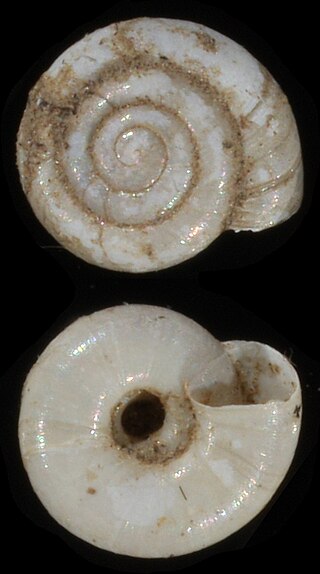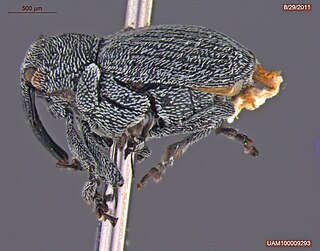
Self-pollination is a form of pollination in which pollen from the same plant arrives at the stigma of a flower or at the ovule. There are two types of self-pollination: in autogamy, pollen is transferred to the stigma of the same flower; in geitonogamy, pollen is transferred from the anther of one flower to the stigma of another flower on the same flowering plant, or from microsporangium to ovule within a single (monoecious) gymnosperm. Some plants have mechanisms that ensure autogamy, such as flowers that do not open (cleistogamy), or stamens that move to come into contact with the stigma. The term selfing that is often used as a synonym, is not limited to self-pollination, but also applies to other type of self-fertilization.

Capsella is a genus of herbaceous plant and biennial plants in the family Brassicaceae. It is a close relative of Arabidopsis, Neslia, and Halimolobos.

Capsella bursa-pastoris, known as shepherd's purse because of its triangular flat fruits, which are purse-like, is a small annual and ruderal flowering plant in the mustard family (Brassicaceae). It is native to eastern Europe and Asia minor, but is naturalized and considered a common weed in many parts of the world, especially in colder climates, including British Isles, where it is regarded as an archaeophyte, North America and China, but also in the Mediterranean and North Africa. C. bursa-pastoris is the second-most prolific wild plant in the world, and is common on cultivated ground and waysides and meadows.

Megaspores, also called macrospores, are a type of spore that is present in heterosporous plants. These plants have two spore types, megaspores and microspores. Generally speaking, the megaspore, or large spore, germinates into a female gametophyte, which produces egg cells. These are fertilized by sperm produced by the male gametophyte developing from the microspore. Heterosporous plants include seed plants, water ferns (Salviniales), spikemosses (Selaginellaceae) and quillworts (Isoetaceae).

Vitrea is a genus of small, air-breathing land snails, terrestrial pulmonate gastropod mollusks in the family Pristilomatidae.

The Donacidae, the "bean clams" or "wedge shells", are a family of bivalve molluscs of the superfamily Tellinoidea. The family is related to the Tellina.

Donax hanleyanus, common name the wedge clam, is a marine bivalve mollusk species in the family Donacidae, the bean clams or wedge shells. It is widely distributed throughout the sandy beaches of the Atlantic coast of South America, from Brazil to Argentina.
British NVC community OV13 is one of the open habitat communities in the British National Vegetation Classification system. It is one of eight arable weed and wasteland communities of fertile loams and clays.
British NVC community OV14 is one of the open habitat communities in the British National Vegetation Classification system. It is one of eight arable weed and wasteland communities of fertile loams and clays.
British NVC community OV19 is one of the open habitat communities in the British National Vegetation Classification system. It is one of six communities characteristic of gateways, tracksides and courtyards.

Tellinoidea is a taxonomic superfamily of saltwater clams, marine bivalve molluscs in the order Cardiida.

Capsella rubella, the pink shepherd's-purse, is a plant species in the genus Capsella, a very close relative of Arabidopsis thaliana and a member of the mustard family, Brassicaceae. It has a very similar appearance to Capsella bursa-pastoris, but C. rubella has a diploid genome, whereas C. bursa-pastoris is tetraploid. Capsella rubella is used as a model plant to study the evolution of self-incompatibility into self-compatibility in plant reproduction. The species is found mostly in Mediterranean region. Separation of this species from its closest ancestor is predicted to have happened around 30,000 to 50,000 years ago.
Donax is the scientific name of two genera of organisms and may refer to:
Capsella orientalis is a plant species described by Mikhail Vasilevich Klokov. Capsella orientalis is a part of the genus Capsella, and the family Brassicaceae.
Capsella grandiflora is a species of flowering plant in the Brassicaceae family. It is referred to by the common name grand shepherd's-purse and is a close relative of Arabidopsis thaliana. It is predicted together with Capsella orientalis to be the surviving progenitor of Capsella bursa-pastoris.

Ceutorhynchus rapae, the cabbage curculio, is a species of minute seed weevil in the beetle family Curculionidae. It is found in North America and Europe. It feeds on Erysimum crepidifolium, Erysimum cheiranthoides, and Capsella bursa-pastoris.
HATS-3 is an F-type main-sequence star 1,380 light-years away. Its surface temperature is 6351±76 K. HATS-3 is relatively depleted in its concentration of heavy elements, with a metallicity Fe/H index of −0.157±0.07, but is slightly younger than the Sun at an age of 3.2+0.6
−0.4 billion years.

Cardiida is an order of bivalves belonging to the class Bivalvia.










